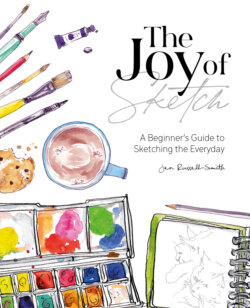Читать книгу The Joy of Sketch - Jen Russell-Smith - Страница 11
На сайте Литреса книга снята с продажи.
ОглавлениеPRACTICALITIES
So, you’ve got your pen and your sketchbook or paper, and you’ve hopefully filled the first couple of pages with your colour chart and doodles. Now is a good time to look a little more closely at some of the practicalities of sketching with your materials.
As I mentioned when thinking about choosing your pen, whether or not your ink is waterproof will be a big feature of how you approach your sketches, along with how long it takes to dry. The waterproof ink I use takes quite a while to dry, and even longer to be fully waterproof, so I know that if I work too quickly, I’ll probably smudge it. Look back at the last couple of exercises and think about whether your ink dried straight away or if you had to leave it a few minutes? I sometimes complete a sketch and then come back to it later (or even another day) to add the colour. This actually works well if you’re working around other activities, or time is precious.
If you’re working with non-waterproof ink, a good approach can be to add paint first, and then draw over the top. The leaves here were painted this way – a quick sweep of the green, a bit more paint detail once that had dried, then a few ink lines over the top. You can also see that I smudged it!
I’m aware watercolour might seem like an odd choice of paint for quick, contemporary results – it’s got a bit of a reputation for ultra-traditional, wishy-washy landscapes and florals. But it’s also quick to use, lively (wet paint has a life of its own), eminently portable and easy to clean up. And while it might not have quite the depth or strength of colour you get with oil paint or acrylics, it’s still possible to create a vibrant splash on the page.
I’m not going to go into a huge amount of detail about watercolour painting – it would need a book for itself, and there are plenty out there once you’ve made a start! The key thing to remember is that wet colours will run together. But if you add one colour and allow it to dry, you can then add another with a sharper line between. Watercolour paint, on the page, is also translucent – you’ll see any previous colours through it and they will mix to create a new shade even when they’re dry.
TIP: CHOOSING COLOURS
Most watercolour palettes will come with a range of paint already included (usually a warm and a cool version of each colour), which are great for making a start. Over time, it will be quite obvious which colours you prefer (they’ll run out fastest) and which you avoid, and you can make a choice about adding more of your preferred shades and getting rid of the ones you don’t like. Or perhaps you could be brave and challenge yourself to use the neglected ones?
